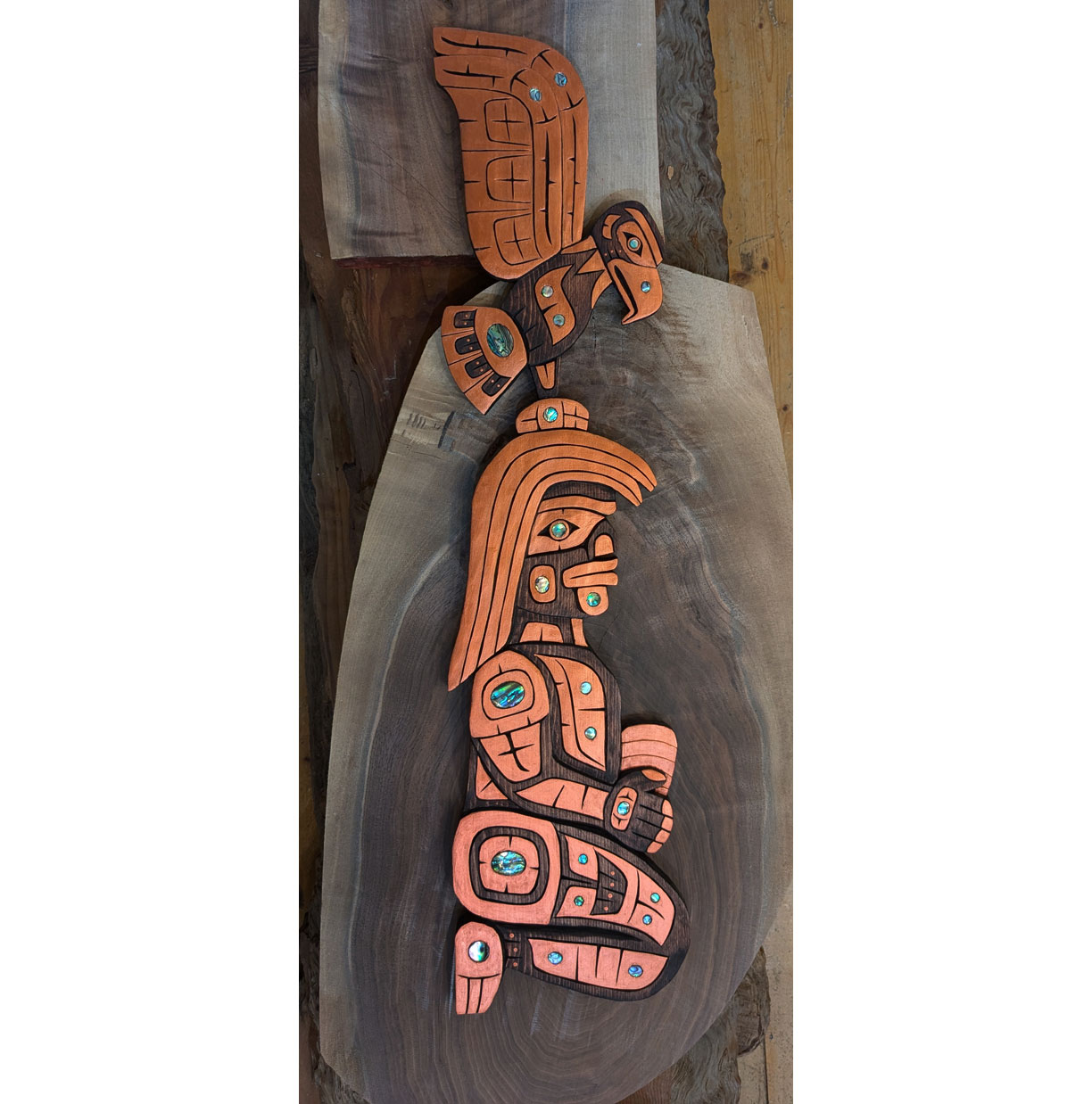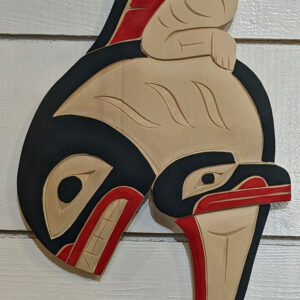First Nations Wild Man with Eagle and Horse Clam
$2,028.00
This masterfully executed and quirky First Nations carving measures 20 X 7.5 X .75 inches, priced at $2028. Featured is a wild man, famed character of First Nations lore, with an eagle companion. The wild man is preparing to enjoy a delicious horse clam, al fresco, with flapping Eagle shown landing on his head. This artist has used a contemporary copper paint wash and 23 abalone shell inlay pieces to set off the masterful carved red cedar.
Hold your mouse cursor over the photo to check out the amazing detail!
The Salish word for “wild man” or “hairy man” is Sasq’ets, which is believed to be the origin of the English term “Sasquatch”. The term “wild man” also can be applied to another mythical character, the Bukwus, see below.
The artist was born in 1963. He is a member of the Kwakwakaw’wakw, also known as Kwakiulth or Kwagiulth First Nation, origination from Alert Bay in their ancestral lands. When he was 11 years old, he knew he wanted to carve. He later learned advanced techniques and skills of carving from the amazing George Hunt Jr. He also worked closely for over 15 years with his cousin, the world-renowned artist Beau Dick. This artist was trained by the very best and he follows in their steps.
Today he is achieved carving mastery and is known for playful and impressive subjects alike, and for his very detailed work, often featuring precise Mother-of-Pearl inlay in abundance, and brilliant coppery paint colors.
Bukwus (sometimes “bakwas”, “bokwus”, “bookwus” or “bukwis”) is one of the supernatural spirits of the Kwakwaka’wakw people of coastal British Columbia.
Bukwus is a spirit of the dead identified with an afterlife realm inhabited by various ghosts, especially the souls of those who have drowned. Bukwus may serve as the guide between the realms of life and the afterlife. Depending on the myth, Bukwus may also contribute more directly to their deaths.
Bukwus is often called “wild man of the woods” and is described as a gaunt, haggard wild man with a bony face. He is dressed in ragged garments and has long, disheveled hair.
He lives in an invisible house in the forest and the spirits of the drowned congregate there. In some myths he is described as the consort of dzunukwa, and the father of her children.
Bukwus emerges from the forest very early in the morning before too many people are about. He eats ghost food out of cockle shells. Bukwus lingers at the forest threshold at the shore or along forest paths, offering assistance and food to people who are lost. He tries to offer his ghost food to living humans who are stranded in the woods, in order to bring them over to the ghost world. Those who eat Bukwus’ food end up in Bukwus’ realm of the dead.
In traditional Kwakiutl cosmology, Bukwus is clearly a spirit. He is the subject of carved shamanic masks and appears during rituals, especially the traditional winter dance. However, he is now sometimes also identified with Bigfoot or Sasquatch and thus assumed to be a cryptid, an as yet unidentified living being.
In some lore, Bukwus is also known as a Cannibal Giant of the coastal Northwest.
Variant names: Boks or Puks (Bella Coola/Salishan), Bowis (Tsimshian/Penutian), Pi’kis (Nass-Gitksian/Penutian), Pokwas, Pukmis (Nootka/Wakashan), Pukwubis (Makah/ Wakashan).





